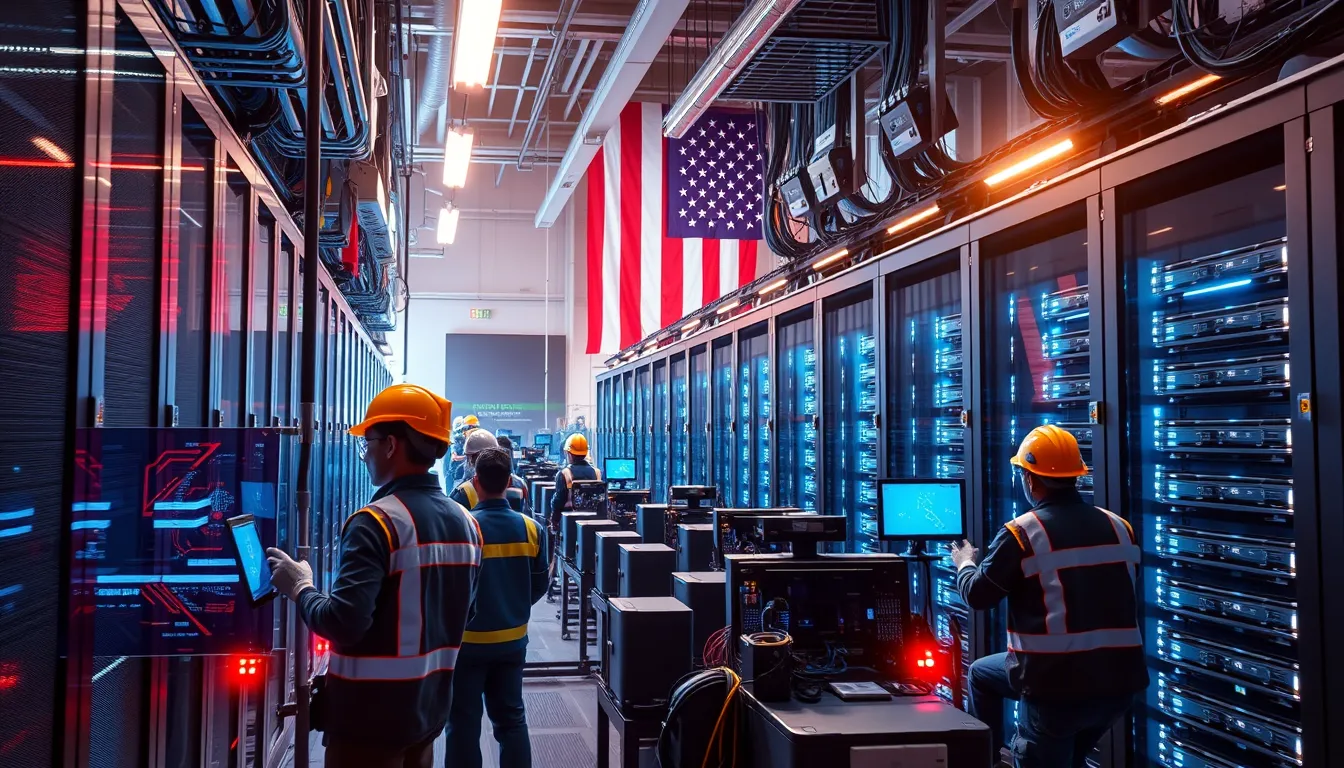Now Reading: Biden Executive Order Fuels AI Data Centers & Clean Energy
-
01
Biden Executive Order Fuels AI Data Centers & Clean Energy
Biden Executive Order Fuels AI Data Centers & Clean Energy

Biden Executive Order Fuels AI Data Centers & Clean Energy
Introduction
President Joe Biden has signed a historic executive order that is poised to redefine the nation’s approach to technology and sustainable energy. The Biden executive order AI data centers initiative not only fast-tracks the development of advanced AI infrastructure but also intertwines this growth with a strong commitment to clean, renewable energy. As the demand for AI capabilities surges, this policy marks a pivotal shift in how data centers are powered and constructed, ensuring that technological progress and environmental stewardship go hand in hand.
In today’s evolving digital landscape, the integration of cutting-edge technology with sustainable practices is not merely a trend—it is a national imperative. As AI systems become more complex and power-hungry, the need for robust, environmentally sound infrastructure has never been more urgent. This executive order aims to meet that challenge by leveraging federal resources and policy innovations that foster both economic growth and environmental safety.
Overview of the Executive Order
The executive order lays out a comprehensive plan that balances technological ambition with meaningful environmental impacts. Key elements of the order include a range of initiatives designed to expedite the establishment of AI data centers while ensuring that these facilities are powered by clean energy. The order emphasizes several core components:
- Leasing federal land for the construction of gigawatt-scale AI centers
- Prioritizing the use of U.S.-made technology and domestic semiconductors to secure the supply chain
- Streamlining permitting processes and facilitating grid connections to overcome bureaucratic hurdles
Each of these components is carefully designed to address the multi-dimensional challenges that face the development of AI infrastructure in the modern era. By leasing federal land, the executive order aims to provide the necessary physical space for expansive data center projects. Meanwhile, the focus on domestic technology not only reinforces national security but also promotes innovation and job creation in the semiconductor and high-tech manufacturing industries.
Accelerating AI Infrastructure Development
One of the most significant aspects of the Biden executive order is its emphasis on speed and efficiency in building AI infrastructure. The rapid expansion of AI technologies has led to unprecedented power demands, with some advanced AI models projected to require up to five gigawatts of power. In light of this, the order outlines several measures to ensure that infrastructure development keeps pace with technological advancements:
- Fast-tracking the construction and operationalization of AI data centers to support burgeoning energy needs
- Implementing efficient, streamlined processes for permitting and grid connectivity to reduce project delays
- Mobilizing federal support to resolve challenges related to the power capacity requirements of large-scale AI operations
The streamlined permitting processes are particularly noteworthy. By cutting through administrative red tape, the order significantly reduces the time it takes to bring new data center projects to fruition. This approach ensures that AI initiatives are not stalled by regulatory delays, thereby keeping the United States at the forefront of technological innovation and production.
Moreover, addressing the immense power requirements of modern AI systems is a critical challenge that this executive order confronts head-on. Building infrastructure that can reliably support high-demand operations is not only about increasing capacity but also about doing so in an environmentally responsible manner. The integration of renewable energy sources into the power supply for these AI centers serves as a model for sustainable growth in the digital age.
Clean Energy and U.S. Leadership
Beyond the technical advancements, the executive order underscores the importance of clean energy in powering AI data centers. This dual-focus strategy enhances U.S. leadership in multiple domains:
- Sustainable Energy Consumption: By mandating that AI data centers incorporate renewable energy sources, the initiative reduces the carbon footprint associated with unprecedented increases in energy use. The move towards sustainability is integral to combating climate change and ensuring long-term environmental health.
- Bolstering U.S. Leadership in AI Development: By combining the drive for advanced AI infrastructure with sustainable energy practices, the United States strengthens its position as a global leader in technology and innovation. The dual strategy sends a clear message to the international community about America’s commitment to ethical and forward-thinking policies.
- Growth in Domestic Semiconductor and High-Tech Sectors: The emphasis on using U.S.-made technology stimulates growth in critical industries. It promotes a more secure and resilient supply chain, which is vital for both national security and economic stability.
This executive order represents a significant strategic pivot by integrating energy sustainability into the core infrastructure of AI development. It recognizes that future advancements in artificial intelligence must be built on a foundation that is not only innovative but also environmentally responsible. In practical terms, this means designing data centers that are equipped with renewable energy installations—such as solar and wind farms—and exploring ways to enhance energy efficiency through advanced cooling and power management technologies.
Economic Impact and Technological Innovation
The economic ramifications of this executive order are profound. By setting a clear policy direction, the administration sends a strong signal to investors, innovators, and private sector companies. The deliberate move to fast-track AI infrastructure development stimulates significant capital investment in the technology and energy sectors. As a result, we can expect:
- An influx of investment in both AI research and clean energy projects
- Increased collaboration between government entities, private firms, and academic institutions
- The emergence of new business opportunities in the fields of renewable energy installation and high-tech construction
At the heart of this economic strategy is the recognition that technological innovation cannot occur in isolation. The success of AI depends on a well-integrated ecosystem where hardware, software, and energy infrastructure converge to create a resilient framework for future development. By supporting domestic production of semiconductors and advanced technologies, the order also helps secure the nation’s supply chains against geopolitical uncertainties. This level of preparedness is crucial in an increasingly competitive global market where technological self-reliance is a cornerstone of national security.
Environmental and National Security Considerations
Environmental sustainability and national security are interwoven themes throughout the executive order. The order acknowledges that as the nation scales up its AI capabilities, there is an equally pressing need to address the environmental impact of such expansion. The initiative’s commitment to clean energy integration is a direct response to these concerns. Key environmental and security aspects include:
- Reducing the carbon footprint of AI data centers by mandating the integration of renewable energy
- Enhancing national security through the promotion of domestic technology production, thus reducing reliance on foreign suppliers
- Creating a sustainable model that can be replicated in other technology-intensive sectors
The focus on national security is particularly relevant given the strategic role that AI and semiconductor industries play in global power dynamics. By prioritizing U.S.-made technology, the policy is not only fostering innovation but also protecting critical infrastructure from external vulnerabilities. This dual approach helps maintain technological sovereignty and impacts long-term strategic advantages in both economic and defense contexts.
Addressing the Challenges and Future Prospects
While the executive order sets an ambitious path forward, implementing such a vast array of initiatives is not without challenges. Some of the hurdles include:
- Navigating complex regulatory environments to expedite approvals while ensuring that all environmental and safety standards are met
- Balancing rapid infrastructure development with meticulous planning to ensure scalability and reliability of AI systems
- Mitigating potential disruptions in the energy grid as new, high-capacity facilities come online
Federal agencies and private stakeholders must work collaboratively to overcome these challenges. The initiative calls for an agile approach where feedback from early projects is used to streamline subsequent endeavors. Furthermore, the policy encourages ongoing research and development into novel energy storage solutions, advanced cooling systems for data centers, and innovative construction methods that minimize environmental impacts.
Looking ahead, the Biden executive order AI data centers initiative is set to become a catalyst for broader change across multiple industries. By serving as a blueprint for integrating technology with sustainable practices, the order lays the foundation for future policies that may extend into other high-energy sectors. The anticipated ripple effects include a stronger emphasis on energy efficiency standards nationwide and increased funding for research into renewable energy technologies that can support a digitally driven economy.
Historical Context and Policy Evolution
To fully appreciate the significance of this executive order, it is important to view it in the context of historical policy trends. Over the past decade, the U.S. government has taken progressive steps to bolster both technological innovation and environmental stewardship. Previous initiatives aimed at enhancing cybersecurity, promoting digital infrastructure, and supporting renewable energy projects have all contributed to the current sophisticated policy landscape.
This executive order builds on those past efforts by integrating them into a cohesive strategy that addresses the current demands of AI and energy consumption. It is a culmination of learning from earlier policies and represents an evolution toward a more integrated, forward-thinking approach to governance. The emphasis on domestic production, clean energy, and rapid technology deployment resonates with earlier initiatives while setting a new, higher bar for future policy-making.
Conclusion
In conclusion, the Biden executive order represents a landmark policy that adeptly combines the realms of technological innovation and environmental sustainability. Through its focus on leasing federal land for expansive AI data centers, prioritizing U.S.-made technology, and streamlining regulatory processes, the order lays a robust foundation for the rapid development of AI infrastructure. Furthermore, the integration of clean energy solutions ensures that this technological revolution is both sustainable and secure.
By addressing the power demands of modern AI systems and fostering a resilient domestic supply chain, this order not only secures U.S. leadership in AI development but also reinforces a commitment to environmental responsibility and national security. As federal agencies, private enterprises, and industry experts collaborate to implement these initiatives, the hope is that this policy will drive a new era of innovation—one where economic growth, technological progress, and sustainable practices are intrinsically linked.
The long-term impact of this executive order will likely be seen in the sustained evolution of the U.S. energy grid, the strengthening of domestic semiconductor production, and the overall advancement of AI technologies. In preparing for the future, the Biden administration has laid out a visionary plan that, if successfully implemented, could serve as a global model for integrating high-tech infrastructure with clean, renewable energy resources.
As stakeholders across sectors assess and respond to these changes, it is clear that the implications extend far beyond the immediate realm of AI. This initiative is a testament to the administration’s commitment to fostering a future where technological innovation is driven by sustainability, resilience, and a holistic approach to national development. The dynamism of this policy will not only propel the United States to the forefront of AI research and deployment but will also inspire analogous efforts worldwide, setting a gold standard for public policy in this digital era.

























